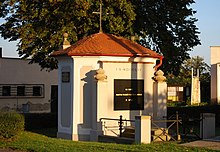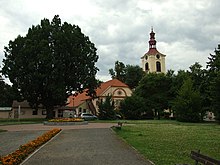Lovosice
| Lovosice | ||||
|---|---|---|---|---|
|
||||
| Basic data | ||||
| State : |
|
|||
| Historical part of the country : | Bohemia | |||
| Region : | Ústecký kraj | |||
| District : | Litoměřice | |||
| Area : | 1189.2662 ha | |||
| Geographic location : | 50 ° 31 ' N , 14 ° 3' E | |||
| Height: | 151 m nm | |||
| Residents : | 8,837 (Jan 1, 2019) | |||
| Postal code : | 410 02 | |||
| License plate : | U | |||
| traffic | ||||
| Street: | D8 | |||
| Railway connection: | 087 Lovosice – Česká Lípa 090 Prague – Děčín 097 Lovosice – Teplice v Č. 113 Lovosice – Most 114 Lovosice – Louny |
|||
| structure | ||||
| Status: | city | |||
| Districts: | 1 | |||
| administration | ||||
| Mayor : | Milan Dian (as of 2014) | |||
| Address: | Školní 407/2 410 30 Lovosice |
|||
| Municipality number: | 565229 | |||
| Website : | www.meulovo.cz | |||
Lovosice ( ; German Lobositz ) is an industrial city in the Aussiger region in the Czech Republic .
Geographical location
The city is located in northern Bohemia at an altitude of 151 m at the foot of the Lovoš ( Lobosch , 570 m) in the south of the Bohemian Central Mountains on the left bank of the Elbe , the course of which forms a knee here: Coming from the east, the river turns in a 90 ° -Bend North. The city is located in the area where the Modla (Model) flows into the Elbe. To the south to the capital Prague it is about 70 km, to the state border in the north to Zinnwald (Saxony / Germany) about 40 km, to the former district town Litoměřice (Leitmeritz) in the east about 10 km.
history
Early settlement
The first people settled in this area as early as millennia before Christ: there are excavations from the early period (3800–2000), from the Bronze Age and the following Iron Age . In the first century after Christ, the tribe of the Marcomanni settled here on the Elbe, which was gradually displaced by Slavs in the 5th and 6th centuries .
First mention by name and changing owners
Lobositz was first mentioned in a document on April 12th 1143 in connection with the transfer of the village to the newly founded Strahov Monastery by Duke Vladislav II . In 1248 it was bought by a family from nearby Leitmeritz, which Lobositz soon gave back to the Altzella monastery near Meißen. In 1348 the monastery succeeded in obtaining the profitable ferry rights for the place. Lobositz was pledged in 1415, initially to the knights of Kladno Castle and in 1511 to the Saxon court marshal Heinrich von Schleinitz , with Altzella still asserting claims to the place for a long time.
In the Hussite Wars , Lobositz suffered considerable damage, which was mainly the result of the fighting over the neighboring castles Hasenburg and Kostial, which were loyal to the emperor . From 1545 Georg von Schleinitz built a castle in the Renaissance style on the site of an old fortress . At the end of the 15th century, the place came to the Lords of Waldstein , who in 1600 received town charter for Lobositz from Emperor Rudolf II , while Leitmeritz was unsuccessful. In 1653 the city became part of the margraviate of Baden , and in 1783 to the Schwarzenberg princes .
The first battle of the Seven Years' War , in which Prussians and Austrians faced each other, took place near Lobositz in 1756 ( Battle of Lobositz ) and caused severe damage to the city. Fires in 1787, 1796 and 1809 caused further damage. In the 19th century the city took u. a. a rapid economic upswing also through the early railway connection in the direction of Prague and Aussig . At the end of the 19th century there was a chemical research institute, several factories and production facilities in Lobositz, and fruit and wine growing were practiced. The population also increased sharply. Lobositz belonged at the end of the 19th century within the Habsburg monarchy to the Bohemian district administration Leitmeritz and was the seat of a district court.
Lobo seat from the 20th century
After the establishment of Czechoslovakia in 1918, the princes of Schwarzenberg were partially expropriated, and the Bohemian (now: Czech) farm workers primarily benefited from a land reform in 1926. Until the beginning of the National Socialist persecution of the Jews there was lively Jewish life in Lobositz.
According to the Munich Agreement , Lobositz belonged from September 30, 1938 to 1945 as part of the Sudetenland to the district of Leitmeritz , district of Aussig , in the Reichsgau Sudetenland of the German Reich .
From May 20, 1944 to May 7, 1945 before the end of the Second World War, there was a satellite camp of the Flossenbürg concentration camp , whose 84 prisoners had to do forced labor for the SS troop support.
After the end of the Second World War , the German residents were expropriated and expelled on the basis of the Beneš decrees . In the 1950s, large parts of the eastern neighboring town of Prosmyky (Prosmik) were demolished for the construction of a coal port. The shipping of the fuel arriving by rail from the Brüxer Revier up the Elbe to Eastern Bohemia proved to be an unsuitable endeavor, as the cargo ships returned downstream without cargo. After the coal port was closed, an industrial area was created in the 1970s for the now incorporated Prosmyky, whose old buildings were completely demolished.
Demographics
Since the Thirty Years' War, the Habsburg politics have made the population increasingly German. Czech immigration increased at the end of the 19th century and reached its peak in the First Czechoslovak Republic . The language border ran not far from the city .
| year | Residents | German | Czechs | Remarks |
|---|---|---|---|---|
| 1830 | 1,122 | - | - | in 163 houses, including 117 Israelites |
| 1854 | 1,396 | - | - | City area 1587 yoke 1270 fathoms |
| 1880 | 4,273 | 3,687 | 522 | (no information for urban areas) |
| 1890 | 4,269 | 3,721 | ? | City area 908 ha |
| 1900 | 4,583 | 3,927 | 586 | City area 908 ha, mostly German residents |
| 1910 | 5,076 | 4.212 | 789 | City area 908 ha |
| 1921 | 5,088 | 3,440 | 1,492 | City area 908 ha |
| 1930 | 5,929 | 3.711 | 1999 | City area 908 ha |
| 1939 | 5,151 | - | - | City area 908 ha |
| 1943 | 6,245 | - | - | City area 908 ha |
| year | Residents | German | Czechs | Remarks |
|---|---|---|---|---|
| 1950 | 5,233 | - | - | City area 908 ha; Reduction through displacement |
| 1970 | 9,349 | - | - | City area 908 ha |
| 1991 | 9,708 | 37 | 9,528 | City area 1189 ha |
City structure
No districts are shown for Lovosice. Basic settlement units are Hlavní nádraží, K Lukavci, Lovosice-střed, Lovošská, Na médii, Nový Klapý, Ostrov, Pod Lovošem, Prosmyky ( Prosmik ), Stadion, Teplická, Terezínská, U Labe, U zastávky and, V cihenken.
The municipality is divided into the cadastral districts of Lovosice and Prosmyky.
Town twinning
- Coswig , Germany
economy
As the third population group alongside the Czechs and Germans, Judaism played a role primarily in the economy. At the end of the 19th century, sugar, candy and coffee substitute production as well as the brewery were the most important economic factors in Lobositz . There was also lively trade in the town and fruit was grown in the area with success.
The Bohemian luster factory was established after the First World War . It has been in Austrian ownership since 1989. Until 1945 there was the DELI chocolate and sugar confectionery factory , a sugar factory, an oil and fodder cake factory, the fruit processing company FRUTA and a large synthetic fertilizer and sulfuric acid factory. During the time of affiliation to Czechoslovakia, a rich industry such as chemical factories, mechanical engineering and electronics companies developed in Lobositz and the surrounding area . Industrial development has stagnated since 1990.
traffic
Railway lines
- 087 Lovosice – Česká Lípa (former North Bohemian Transversal Railway )
- 090 (Prague–) Kralupy nad Vltavou – Ústí nad Labem – Děčín (former kk Northern State Railway ), main line on the left Elbe
- 097 Lovosice – Teplice v Čechách
- 113 Lovosice – Most (former Brüx-Lobositz connecting railway )
- 114 Lovosice – Louny
Trunk roads
- Motorway D 8 ( E 55 ): Prague - (border with Germany) - Dresden (exits Lovosice-vychod [east] and Lovosice-západ [west])
- State road I / 8 (E 55) Lovosice – Junction Road 608-Teplice-Cínovec-Altenberg (Ore Mountains).
- State road I / 30 Lovosice – Ústí nad Labem in the Elbe Valley
- State road I / 15 Most – Lovosice (Elbe bridge) –Litoměřice
Attractions
- Saint Wenceslas Church , consecrated in 1745
- the town hall
- Schwarzenberg Castle, the center of the Schwarzenberg rule until 1848, has been preserved from the historical building stock.
It was rebuilt in the baroque style after the city fire .
sons and daughters of the town
- Maximilian Bittner (1869–1918), orientalist
- Karl von Czyhlarz (1833–1914), Bohemian-Austrian lawyer and politician
- Alfons Dopsch (1868–1953), Austrian historian
- Eberhard Eysert (1868–1920), painter in Leitmeritz
- Gustav Schröpler (1830–1901), painter
- Karl Tutte (October 1875 in Lobositz; † July 6, 1925 Groß Tschernitz near Saaz ), teacher and headmaster in Satkau , local researcher and editor of the standard work "The political district of Saaz" (Saaz 1904)
literature
- Joachim Bahlcke , Winfried Eberhard, Miloslav Polívka (eds.): Handbook of historical places . Volume: Bohemia and Moravia (= Kröner's pocket edition . Volume 329). Kröner, Stuttgart 1998, ISBN 3-520-32901-8 .
Individual evidence
- ↑ http://www.uir.cz/obec/565229/Lovosice
- ↑ Český statistický úřad - The population of the Czech municipalities as of January 1, 2019 (PDF; 7.4 MiB)
- ↑ a b seat of praise . In: Meyers Großes Konversations-Lexikon . 6th edition. Volume 12, Bibliographisches Institut, Leipzig / Vienna 1908, p. 645 .
- ^ Website of the Flossenbürg Concentration Camp Memorial Accessed July 6, 2016
- ↑ Johann Gottfried Sommer : The Kingdom of Bohemia . Volume 1: Leitmeritzer Kreis , Prague 1833, p. 98, item 1).
- ↑ Yearbooks of the Bohemian Museum of Natural and Regional Studies, History, Art and Literature . Volume 2, Prague 1831, p. 197, paragraph 19).
- ↑ http://www.uir.cz/zsj-obec/565229/Obec-Lovosice
- ↑ http://www.uir.cz/katastralni-uzemi-obec/565229/Obec-Lovosice
- ^ The teacher Karl Tutte (Czech) (accessed on August 8, 2015)








